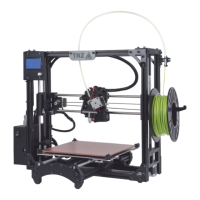Slic3r in Depth
ABS usually needs more cajoling and, whilst it can print well on PET
and Kapton, there are reports that people have success by applying hairspray
to the bed before printing. Others have reported that an ABS slurry (made
from dissolving some ABS in Acetone) thinly applied can also help keep
the print attached.
No cooling.
Directly related with the above, it makes no sense to increase
the temperature of the first layer and still have a fan or other cooling
mechanism at work. Keeping the fan turned off for the first few layers is
generally recommended. Of course, some models may need direct cooling
due to their size, but this would be an exception.
Simple Mode
Slic3r has two modes of operation, Simple and Expert. These may be chosen
from the Preferences window (found under the File menu).
As is expected, the simple mode offers a reduced set of options, enough
for the beginner to get started with. The expert options give more control
over how Slic3r produces the gcode and will be looked at later.
Print Settings
The
Print Settings
tab provides the opportunity to change settings related
to the actual print. Whereas the other tabs are changed rarely, the settings
on this tab will be modified regularly, possibly for each model printed.
General. Layer height
is the thickness of each layer, and it is the step
along the vertical axis taken before extruding a new layer atop the previous
one. There are several factors that influence how high each layer should be:
• Desired resolution
- Lower layer height should result in prints with
less noticeable ribs or bands, as each layer is smaller. Aesthetics plays
a role here, but also the type of model, for example, a mechanical part
50

